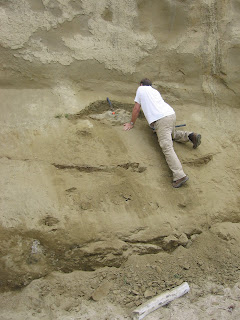Last August I had the fortune of excavating a Pliocene mysticete skull from one of my fossil localities in the Purisima Formation. I actually discovered this skull back in 2005, but had already found another that I preferred to excavate instead. I went ahead and excavated that other specimen instead, and left this one here. There were several reasons why I left this one alone. First, the other specimen was much closer to where we could park, whereas it was a mile walk to the skull featured below. Secondly, I only had the funds (and space in my small car) for one large plaster jacket, so this one had to wait.
The skull as it appeared prior to excavation, and in a basically identical
state at the time of discovery in 2005.
state at the time of discovery in 2005.
My permit for the locality was good for another year, so why didn't I collect it in 2006? Well, I was still preparing the 2005 whale (which I would be preparing for another four more years), and there wasn't lab space available for it. So my 2006 permit expired, and I didn't get another one until last fall. To be honest, I hadn't intended on collecting it this year either because I had no funding, no crew, and no vehicle to remove it with. One day a well known "personality" posted a question about fossil whales in concretions on the shores of some of the Channel Islands, and he was legitimately surprised by how many whales there are out there languishing, despite the number of able bodied vertebrate paleontologists in southern CA. I went on a bit of a rant and explained that it's the rule rather than the exception with regards to California fossil whales: there are uncollected bones and concretions littering Northern and Central California beaches, just asking to be put into a museum. I didn't think much of my email, until I got an email from Dr. Desmond Maxwell at University of the Pacific in Stockton, who explained that he had grown tired of taking his field crews all the way to Utah and Montana, and wanted some local prospects, and that he had plenty of funding, volunteers, and lab space for large marine mammal fossils. I gladly took him up on his offer, and this whale excavation was the "maiden voyage" of our field/lab collaboration.
The fossil, with estwing superpick for scale.
We arrived on the Thursday of the last week of August, with the intention of spending four days on the excavation. I met Des early in the morning at his hotel, and we drove out to the coast. The first day felt like two, both in terms of how much rock we went through and how long it was. The skull was in a concretion about ten feet up off the sand, and fortunately, had not been eroded at all since I found it in 2005 - at this locality, erosion is particularly slow, and the cliff erodes inch by inch, instead of being cut at the base and having blocks fall down, like at Capitola. Fossils that are over ten feet above the base of the cliff erode very slowly - a large baleen whale vertebra at another locality had the tip of its neural arch exposed in summer 2004, and as of October 2011, one half of the ventral side of the centrum is left (body of the vertebra).Footholds cut into place for the excavation.
The first order of business was to cut footholds and ledges for us to stand on. Unlike the 2005 baleen whale excavation, the sandstone was very soft and friable; its height above the base of the cliff meant it spends more time out of the year being weathered and not waterlogged by high tides one half of the year. This made the excavation on the first day go remarkably fast.
Initial excavation of the skull, and cleaning of the exposed surfaces.
 Des excavating the mysticete skull.
Des excavating the mysticete skull.
There were also several plants growing in the concretion, which we quickly plucked and removed. Fortunately, the roots did not penetrate the bone and destroy it, which has happened in some cases. After some early cleaning, it was apparent that the concretion was very thin over some parts of the skull, which would make life considerably easier than the previously excavated whale from this locality.
 Des excavating the mysticete skull.
Des excavating the mysticete skull.What exactly was it? It's convenient to just throw around the term 'whale' because it's huge, and you're not really quite sure. Well, initially I identified it as a right whale (balaenid), because I thought that the skull shape was consistent with that - wide braincase with a supraoccipital shield that did not extend very far forward. A few weeks later, I looked at more pictures of right whales, and I'm no longer too convinced my ID was accurate by any stretch of the imagination. Right whales have 'backswept' squamosals, and whatever this thing is, it's squamosals (it is sadly missing the lateral extremities of them) are relatively close to the vertex (top of the skull). More likely, it is a primitive balaenopterid with a short supraoccipital shield: the squamosals of balaenopterids are closer to the vertex than in balaenids, and are oriented laterally (not posterolaterally). Another possibility is that it could belong to a balaenopterid-like gray whale, which is known from the Pliocene San Diego Formation.

The skull after the first day of work. Not much appears obvious, but I'll talk more about it in the next installment.







